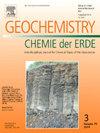REE and trace element mobility during the transformation of basalt to laterite and bauxite, Payas Province, Türkiye
IF 2.9
3区 地球科学
Q2 GEOCHEMISTRY & GEOPHYSICS
引用次数: 0
Abstract
The bauxites of the Payas area in the eastern Mediterranean region of Turkey occur as a stratigraphically continuous layer between Early and Late Cretaceous shallow marine carbonates. The laterites represent an in situ formation and mark a key stratigraphic layer in the region. Bauxite pockets are also present in the laterites, formed from the reworking of the laterites and accumulated in depressions in the karst terrain. Therefore, bauxite occurrences are found locally in this stratigraphic layer. The parental rock was a Ti-rich basalt that is compositionally similar to Hawaiian basalts, as indicated by petrographic features and distinctive trace element composition (Zr/TiO2 and Nb/Y). The behavior of elements during the lateritization and bauxitization processes was interpreted using the composition of the Hawaiian basalts with the iron laterite and Ti-rich bauxites of the Payas Region. During lateritization, Fe, Al, Ti, Cr, Nb, and Ta, were largely immobilie while REE and other trace elements, except for Rb, Ni, Co, and Pb were significantly removed. Approximately 75 % of the REE were removed at the end of the bauxitization and/or transportation of the lateritic soil into the karstic depressions. REE were not equally mobile with La to Ce and Lu to Yb having a relatively lower mobility than highly mobile middle REE. During the transformation of laterite to bauxite, low mobility elements such as Ti, Nb, Th, Cr, Hf, and Sn were enriched in the bauxite phase. In comparison to other elements, Rb, As, Pb, Mo, and Ni were strongly removed from the lateritic material during the bauxitization processes. The transfer of MREE during lateritization and bauxitization would have resulted in the enrichment of both light and heavy REE (concave pattern) in contemporaneous seawater. In other words, silicate weathering periods on land should be marked by a concave REE pattern with positive Eu anomaly in marine sediments throughout the geological period.
土耳其帕亚斯省玄武岩向红土和铝土矿转化过程中的稀土元素和痕量元素流动性
土耳其东地中海地区帕亚斯地区的铝土矿是早白垩世和晚白垩世浅海碳酸盐岩之间的地层连续层。红土代表原地形成,是该地区的一个重要地层。红土中还存在铝土矿块,这些铝土矿块由红土再加工形成,并在喀斯特地貌的洼地中堆积。因此,该地层中局部存在铝土矿。母岩是富钛玄武岩,从岩石学特征和独特的微量元素成分(Zr/TiO2 和 Nb/Y)来看,其成分与夏威夷玄武岩相似。利用夏威夷玄武岩与帕亚斯地区的红土铁矿和富钛铝土矿的成分,解释了红土化和铝土化过程中元素的变化情况。在红土化过程中,铁、铝、钛、铬、铌和钽在很大程度上被固定,而稀土元素和其他微量元素(铷、镍、钴和铅除外)则被大量移除。大约 75% 的稀土元素在铝矾土化结束和/或将红土运入岩溶洼地时被去除。稀土元素的流动性不尽相同,喇至铈和麓至镱的流动性相对低于流动性高的中稀土元素。在红土向铝土矿转化的过程中,铝土矿相中富集了低流动性元素,如 Ti、Nb、Th、Cr、Hf 和 Sn。与其他元素相比,Rb、As、Pb、Mo 和 Ni 在铝土矿化过程中从红土材料中大量移除。红土化和铝矾土化过程中 MREE 的转移将导致同期海水中轻 REE 和重 REE 的富集(凹形模式)。换言之,在整个地质时期,陆地硅酸盐风化期应以海洋沉积物中 Eu 正异常的凹面 REE 模式为标志。
本文章由计算机程序翻译,如有差异,请以英文原文为准。
求助全文
约1分钟内获得全文
求助全文
来源期刊

Chemie Der Erde-Geochemistry
地学-地球化学与地球物理
CiteScore
7.10
自引率
0.00%
发文量
40
审稿时长
3.0 months
期刊介绍:
GEOCHEMISTRY was founded as Chemie der Erde 1914 in Jena, and, hence, is one of the oldest journals for geochemistry-related topics.
GEOCHEMISTRY (formerly Chemie der Erde / Geochemistry) publishes original research papers, short communications, reviews of selected topics, and high-class invited review articles addressed at broad geosciences audience. Publications dealing with interdisciplinary questions are particularly welcome. Young scientists are especially encouraged to submit their work. Contributions will be published exclusively in English. The journal, through very personalized consultation and its worldwide distribution, offers entry into the world of international scientific communication, and promotes interdisciplinary discussion on chemical problems in a broad spectrum of geosciences.
The following topics are covered by the expertise of the members of the editorial board (see below):
-cosmochemistry, meteoritics-
igneous, metamorphic, and sedimentary petrology-
volcanology-
low & high temperature geochemistry-
experimental - theoretical - field related studies-
mineralogy - crystallography-
environmental geosciences-
archaeometry
 求助内容:
求助内容: 应助结果提醒方式:
应助结果提醒方式:


